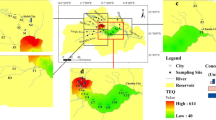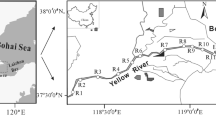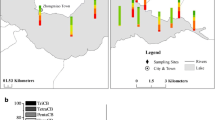Abstract
To assess the level of polychlorinated biphenyl (PCB) contamination and identify their sources, surface sediments were collected from selected locations along Nakdong River, Korea, and analyzed for 209 PCB congeners using high-resolution gas chromatography/high-resolution mass spectroscopy. PCB levels ranged from 0.124 to 79.2 ng/g dry weight (coplanar PCBs 0.295 to 5720 pg/g dry), which were similar to those of three other major rivers (Han, Geum, and Youngsan rivers) in Korea but slightly lower than those in neighboring countries. Regarding homologue composition, tetra-CBs were most abundant in most samples, but some samples with much higher PCBs concentrations had relatively lower proportions of tetra-CBs and higher proportions of penta- to hepta-CBs. To identify the sources of PCBs in sediment samples, principal component analysis/absolute principal component scores (PCA/APCS), positive matrix factorization (PMF), and multiple linear regression (MLR) were used with the congener composition of aroclors (1242, 1248, 1254, and 1260) and the flue gas of waste incinerators (data obtained from a previous article) as source profiles. Results showed that the three models showed similar source apportionments. Most sediment samples with lower PCB concentrations had higher proportions of incineration-derived materials, and some sediment samples with much higher PCB concentrations had higher proportions of aroclor 1260. This occurred because many industrial facilities, such as landfill leachate–treatment facilities, were gathered around sampling points with high PCB concentrations, and high-chlorinated PCBs are more stable in the elution process of landfill leachate than the incineration process. PCB concentrations estimated by APCS, PMF, and MLR were similar to the measured values with coefficients of determination ranging from 0.77 to 0.99.






Similar content being viewed by others
References
Bonifazi P, Pierini E, Bruner F (1997) Solid-phase extraction of PCBs from water containing humic substances. Chromatographia 44:595–600
Donna LB, Ralph JM (1996) Characterization of the polychlorinated biphenyls in the sediments of woods pond: evidence for microbial dechlorination of aroclor 1260 in situ. Environ Sci Technol 30:234–245
Guo H, Wang T, Louie PKK (2004a) Source apportionment of ambient non-methane hydrocarbons in Hong Kong: application of a principal component analysis/absolute principal component scores (PCA/APCS) receptor model. Environ Pollut 129:489–498
Guo H, Wang T, Simpson IJ, Blake DR, Yu XM, Kwok YH et al (2004b) Source contributions to ambient VOCs and CO at a rural in eastern China. Atmos Environ 38:4551–4560
Hong SH, Yim UH, Shim WJ, Oh JR, Lee IS (2003) Horizontal and vertical distribution of PCBs and chlorinated pesticides in sediments from Masan Bay, Korea. Mar Pollut Bull 46:244–253
Hung CC, Gong GC, Jiann KT, Yeager KM, Santschi PH, Wade TL et al (2006) Relationship between carbonaceous materials and polychlorinated biphenyls (PCBs) in the sediments of the Danshui River and adjacent coastal area, Taiwan. Chemosphere 65:1452–1461
Ikonomou MG, Sather P, Oh JE, Choi WY, Chang YS (2002) PCB levels and congener patterns from Korean municipal waste incinerator stack emissions. Chemosphere 49:205–216
Ishikawa Y, Noma Y, Yamamoto T, Mori Y, Sakai S (2002) PCB decomposition and formation in thermal treatment plant equipment. Chemosphere 67:1383–1393
Ito K, Xue N, Thurston GD (2004) Spatial variation of PM2.5 chemical species and source-apportioned mass concentrations in New York City. Atmos Environ 38:5269–5282
Jeong GH, Kim HJ, Joo YJ, Kim YB, So HY (2001) Distribution characteristics of PCBs in the sediments of the lower Nakdong River, Korea. Chemosphere 44:1403–1411
Kim KS (2004) Study on the behavior and mass balance of PCBs in ambient air. Doctoral thesis, University of Yokohama, Yokohama, Japan (in Japanese)
Kim KS, Hirai Y, Kato M, Urano K, Masunaga S (2004) Detailed PCB congener patterns in incinerator flue gas and commercial PCB formulations (kanechlor). Chemosphere 55:539–553
Kim KS, Lee SC, Kim KH, Shim WJ, Hong SH, Choi KH et al (2009) Survey on organochlorine pesticides, PCDD/Fs, dioxin-like PCBs and HCB in sediments from the Han River, Korea. Chemosphere 75:580–587
Kodavanti PR, Senthilkumar K, Loganathan BG (2008) Organohalogen pollutants and human health. In: Heggenhougen HK, Quah S (eds) Encyclopedia of public health, vol 4. Academic Press, San Diego, pp 686–693
Koh CH, Khim JS, Kannan K, Villeneuve DL, Senthilkumar K, Giesy JP (2004) Polychlorinated dibenzo-p-dioxins (PCDDs), dibenzofurans (PCDF), biphenyls (PCBs), and polycyclic aromatic hydrocarbons (PAHs) and 2,3,7,8-TCDD equivalents (TEQs) in sediment from the Hyeongsan River, Korea. Environ Pollut 132:489–501
Lee E, Chan CK, Paatero P (1999) Application of positive matrix factorization in source apportionment of particulate pollutants in Hong Kong. Atmos Environ 33:3201–3212
Lee KT, Tanabe S, Koh CH (2001) Contamination of polychlorinated biphenyls (PCBs) in sediments from Kyeonggi Bay and nearby areas, Korea. Mar Pollut Bull 42:273–279
Liu H, Zhang Q, Wang Y, Cai Z, Jiang G (2007) Occurrence of polychlorinated dibenzo-p-dioxins, dibenzofurans and biphenyls pollution in sediments from the Haihe River and Dagu Drainage River in Tianjin City, China. Chemosphere 68:1772–1778
Loganathan BG, Lam PKS (eds) (2011) Global contamination trends of persistent organic chemicals. CRC Press, Boca Raton
National Institute of Environmental Research (2005) Analytical methods of endocrine disrupting chemicals. NIER, Korea
National Institute of Environmental Research (2007) The 8th monitoring results on endocrine disrupting chemicals in Korea. NIER, Korea
Nicolas J, Chiari M, Crespo J, Orellana IG, Lucarelli F, Nava S et al (2008) Quantification of Saharan and local dust impact in an arid Mediterranean area by the positive matrix factorization (PMF) technique. Atmos Environ 42:8872–8882
Norris G, Vedantham R, Wade K, Brown S, Prouty J, Foley C (2008) EPA positive matrix factorization (PMF): 30 fundamentals & user’s guide. United States Environmental Protection Agency, Office of Research and Development, Washington, DC
Paatero P (1997) Least squares formulation of robust non-negative factor analysis. Chemometr Intell Lab 37:23–35
Paatero P, Tapper U (1994) Positive matrix factorization: a non-negative factor model with optimal utilization of error estimates of data values. Environmetrics 5:111–126
Park SU, Kim JG, Masunage S, Kim KS (2009) Source identification and concentration distribution of polychlorinated biphenyls in environmental media around industrial complexes. Bull Environ Contam Toxicol 83:859–864
Park SU, Kim JG, Jeong MJ, Song BJ (2010) Source identification of atmospheric polycyclic aromatic hydrocarbons in industrial complex using diagnostic ratios and multivariate factor analysis. Arch Environ Contam Toxicol. doi:10.1007/s00244-010-9567-5
Polissar AV, Hopke PK, Paatero P, Malm WC, Sisler JF (1998) Atmospheric aerosol over Alaska 2 elemental composition and sources. J Geophys Res 103:19045–19057
Ren M, Peng P, Chen D, Chen P, Li X (2009) Patterns and sources of PCDD/Fs and dioxin-like PCBs in surface sediments from the East River, China. J Hazard Mater 170:473–478
Shelly LM, Melissa JA, Eileen PD, Jana BM (2002) Source apportionment of exposures to volatile organic compounds. I. Evaluation of receptor models using simulated exposure data. Atmos Environ 36:3629–3641
Shin SK, Kim KS, You JC, Song BJ, Kim JG (2006) Concentration and congener patterns of polychlorinated biphenyls in industrial and municipal waste incinerator flue gas, Korea. J Hazard Mater A133:53–59
Smith JA, Witkowski PJ, Chiou CT (1988) Partition of nonionic organic compounds in aquatic system. Rev Environ Contam Toxicol 103:125–151
Sofowote UM, Mccarry BE, Marvin CH (2008) Source apportionment of PAH in Hamilton Harbour suspended sediments: comparison of two factor analysis methods. Environ Sci Technol 42:6007–6014
Thurston GD, Spengler JD (1985) A quantitative assessment of source contributions to inhalable particulate matter pollution in metropolitan Boston. Atmos Environ 19:9–25
UNEP (United Nations Environment Programme) CHEMICALS (1999) Guidelines for the identification of PCBs and materials containing PCBs, first issue. http://www.chem.unep.ch/Publications/pdf/GuidIdPCB.pdf
Zhang H, Zhao X, Ni Y, Lu X, Chen J, Su F et al (2010) PCDD/Fs and PCBs in sediments of the Liaohe River, China: levels, distribution, and possible sources. Chemosphere 79:754–762
Acknowledgment
This research was supported by research funds from Chonbuk National University in 2010.
Author information
Authors and Affiliations
Corresponding author
Electronic supplementary material
Below is the link to the electronic supplementary material.
Rights and permissions
About this article
Cite this article
Jin, R., Park, SU., Park, JE. et al. Polychlorinated Biphenyl Congeners in River Sediments: Distribution and Source Identification Using Multivariate Factor Analysis. Arch Environ Contam Toxicol 62, 411–423 (2012). https://doi.org/10.1007/s00244-011-9722-7
Received:
Accepted:
Published:
Issue Date:
DOI: https://doi.org/10.1007/s00244-011-9722-7




